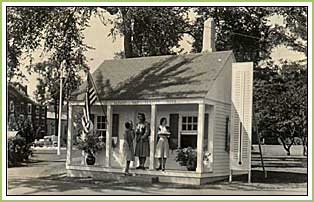
|
 |
 |
 |
 |
|
The town green means change The evolution of the town green's appearance over the course of more than three and one-half centuries reflects corresponding changes in religious practice, civic customs, fashion, economy, and politics. The bucolic appearance of most contemporary greens belies the fact that the first town commons in Connecticut were neither uniformly planned, well maintained, nor beautiful. Proprietors usually set aside the least desirable land for the meetinghouse green„land that couldn't be used for farming. This explains why so many Connecticut greens originated on swampy land. Even though they were closely associated with the meetinghouse, these central town plazas were seldom landscaped. Scattered with tree stumps, they were typically muddy expanses, rutted with cart tracks and often filled with refuse. As late as 1867 Donald Grant Mitchell, a prominent social critic, agronomist, and professional landscape gardener, described the dreary landscapes of New England towns, complaining of the "detestably narrow and muddy streets" and the "wild common over which the November winds swept." Most improvements came after the American Revolution, when many commons were re-cast as business and civic centers, and were cleared of any structures that still existed on the green proper, including the Congregational meetinghouse and churches of other denominations. This last action was particularly true after the separation of church and state was formalized by state constitution in 1818. More significant changes occurred after the Civil War, as time and money for public projects became increasingly available. In the late nineteenth century the green evolved into a landscaped park, and the town library, city hall, and other civic institutions became familiar landmarks along its perimeter. The primary improvements - trees, street lamps, paths, fountains, and benches - were usually added by Village Improvement Societies. These local civic societies, part of a larger New England movement, were run almost entirely by the ladies of the town, who raised funds with bake sales and unofficial "taxes" on green-front property. The Colonial Revival movement of the early twentieth century contributed to the image of neat white buildings and shade trees that distinguish so many Connecticut greens today. |
|||||||||||||||||||||||||||||||||||||
Home | GreenLink
| Exhibits | DataCenter
© 2001–2024 TownGreens.com


